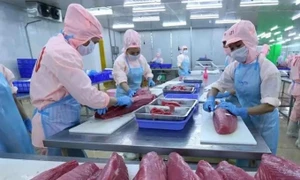
(VNS/VNA) - The Gold Demand Trends report revealed that demand was buoyed by continued recovery from the COVID-19 pandemic as most remaining restrictions were lifted, allowing full economic activity to resume.
In Vietnam, jewellery consumption more than trebled year-on-year to 4 tonnes, the report found, adding that the sizable increase was largely due to the comparison with a very weak third quarter of 2021.
Nevertheless, the Vietnamese recovery had been particularly robust with healthy GDP growth, incomes boosted by reversed salary cuts and companies returning to full employment, all of which boosted demand.
Regarding gold coins and bars, Vietnam saw a particularly significant year-on-year rise in investment demand. It more than trebled to 8 tonnes as local investors again sought refuge in gold, with high demand for chi rings and SJC tael bars.
“Investment demand across Southeast Asian markets was robust on the back of concerns about inflation, local currency depreciations against the US dollar and the sustainability of medium-term economic growth,” the report wrote.
Meanwhile, Phu Quy Jewelry Store sales manager Tran Xuan Dung said that in the third quarter gold jewellery recorded higher demand than in the second quarter.
However, consumption these days is not too high although this is the time of the wedding season.
"In addition, demand for safe-haven storage is not large," Dung said.
According to the report, the global gold demand, excluding over-the-counter (OTC) in the third quarter was 28% higher year-on-year at 1,181 tonnes, driven by stronger consumer and central bank buying which helped year-to-date demand recover to pre-COVID norms.
Jewellery consumption reached a robust 523 tonnes, increasing 10% year-on-year despite the deteriorating global economic backdrop.
Central banks continued to accumulate gold, with purchases estimated at a quarterly record of nearly 400 tonnes. An 8% year-on-year fall in technology demand reflected a fall in consumer demand for electronics due to the global economic downturn.
Investment demand (excluding OTC) for the third quarter was 47% lower year-on-year at 124 tonnes, reflecting weak sentiment among some investor segments.
The report said that 36% growth in bar and coin investment was insufficient to offset 227 tonnes of ETF outflows. “Investment demand diverged on differing priorities. Retail investors bought gold as a store of value amid surging global inflation, while ETF investors reduced their holdings in the face of rising global interest rates.”
The report said that revised down on negative Q3 sentiment but macroeconomic risks and short covering may lure investors back. “A very weak Q3 leads us to believe that a good deal of negative sentiment towards gold has been flushed out of investment. The impact of further policy rate hike surprises and US dollar’s safe-haven strength may be fading. Furthermore, they have already pushed negative gold price sentiment to historical extremes, paving the way for a reversal in trend as some investors may close short positions in Q4.”
Regarding supply, total supply in the third quarter increased by 1% year-on-year as lower recycling offset mine production growth.
Mine production increased to almost 950 tonnes, up 2% following the recovery in Chinese output and fewer technical difficulties elsewhere. Recycled gold supply fell 6%, primarily due to lockdowns in China and limited signs of distress selling in other markets.























